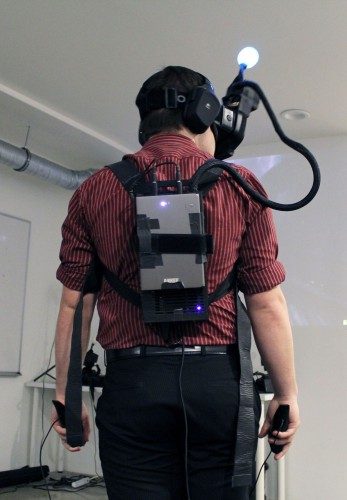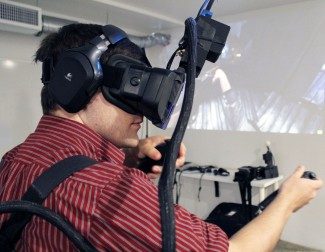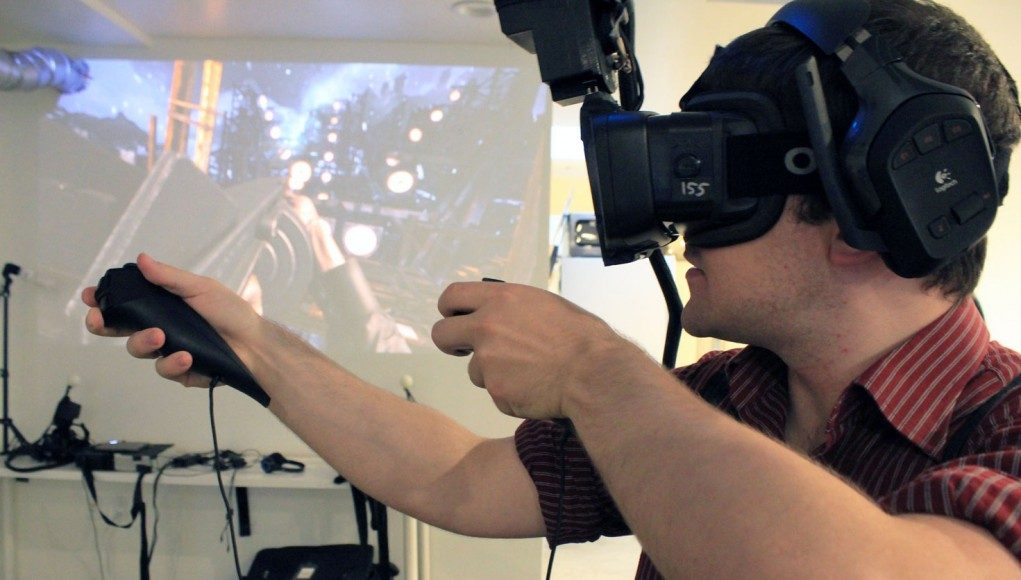Survios, formerly Project Holodeck, continues to work to create a fully immersive virtual reality environment. I got my hands on their latest prototype hardware, dubbed the Prime 3, to slay Zombies on the Holodeck once again.
The last time I was in Survios’ hardware was more than a year ago, before Zombies on the Holodeck even existed. Survios told me the system I used back then was Holodeck 0. Since that time, Survios has progress through Holodeck 1, Holodeck 2, Prime 1, Prime 2, and now the current prototype, Prime 3. Quite a while ago they released the Zombies on the Holodeck demo for Oculus Rift + Razer Hydra, but I hadn’t played it using Survios’ full untethered system, nor the latest build, until now.
 The Prime 3 prototype uses an Oculus Rift HD prototype, Razer Hydra, and PlayStation Move. Housed in a backpack is a tiny computer which powers the entire experience. I was completely surprised to find that there is no dedicated GPU in the backpack—everything I saw with Prime 3 ran directly on an Intel GPU with integrated Iris 5200 graphics, and did so with no performance issues.
The Prime 3 prototype uses an Oculus Rift HD prototype, Razer Hydra, and PlayStation Move. Housed in a backpack is a tiny computer which powers the entire experience. I was completely surprised to find that there is no dedicated GPU in the backpack—everything I saw with Prime 3 ran directly on an Intel GPU with integrated Iris 5200 graphics, and did so with no performance issues.
The Prime 3 prototype provides an untethered VR experience with an 8ft. x 8ft. playing area. If you start to near the edge of your real-world gameplay area, you see a faint virtual fence fade in to let you know that you shouldn’t walk any further.
Survios has been working on hard to find out what kind of user experience works best in VR. Before jumping into the latest build of Zombies on the Holodeck, I found myself in a holodeck loading area with a floating carousel of game covers surrounding me. I could reach out to grab the carousel and give it a spin to see all the available games. To play a game, there’s a big Play button that you reach out to press to load the selected title.
Before killing zombies I visited the virtual shooting range where I was versed in using dual pistols, tommy guns, rifles, shotguns, grenades, and even a bow and arrow. Once I demonstrated my prowess with each, the Survios team loaded me into Zombies on the Holodeck, which has been hugely improved since the experience released for the Oculus Rift and Razer Hydra.
In Zombies on the Holodeck, your only goal is to survive the incoming horde of zombies. There’s a table of weapons before you. Holstered on your sides are two pistols; on your chest is a grenade; on your back, an axe. Physically interacting with the weapons is one of my favorite parts of this experience. You feel like a total badass as you whip out your pistols to fire on a zombie, then quickly spinning and grabbing your axe in one fluid motion to hack apart another as it approaches from behind.
Natural motion interactions add to VR immersion greatly. Instead of learning new button combinations for every game, such motion input allows you to be immediately familiar with how to interact in a game world because its based on what we already know about interacting with the real world. Want to pick something up? Just grab it. Want to throw a grenade? Just throw it.
At one point while playing, I was wielding the shotgun with two hands, with the table of weapons was on my right side. Several zombies were approaching and I needed a bit more fire power. I dropped the shotgun, reached over with my right hand to grab the tommy gun off the table, then virtually tossed it from my right hand to my left hand (because I’m a lefty), then pulled my pistol out of the holster with my right hand and continued to shoot both weapons. I didn’t even know if the game supported a complex interaction like that, but I just did it anyway because that’s what felt natural to do in the given situation—and it worked. No button combos, no abstract dual wielding control scheme. This is the promise of natural VR input.
 On that theme, I’ve been bugging the Survios team to take things even further with their weapon interactions. Pumping the shotgun is universally fun. Realistic reloading, where you have to drop out your clip and insert a new one, add to immersion and gameplay.
On that theme, I’ve been bugging the Survios team to take things even further with their weapon interactions. Pumping the shotgun is universally fun. Realistic reloading, where you have to drop out your clip and insert a new one, add to immersion and gameplay.
In fact, an older build of Zombies on the Holodeck included that feature and it was a blast. Instead of scripted moments, where your character might fumble with a clip as they get caught off guard by a zombie, real interactions like this allow for real moments where a zombie might sneak up behind you while you’re desperately fumbling to reload. These moments are visceral and spontaneous because they’re actually happening, as opposed to being artificially created. Survios tells me they’re trying to strike a balance between usability and realism in this sense, but it’s definitely something they’re aware of.
By the end of my time killing zombies, I really just wanted to keep playing. There’s certainly room for improvement in latency, tracking accuracy, gameplay, etc, but Survios is onto something very special. The bottom line is that I had an absolute blast killing zombies, and I can’t wait to do it again.







